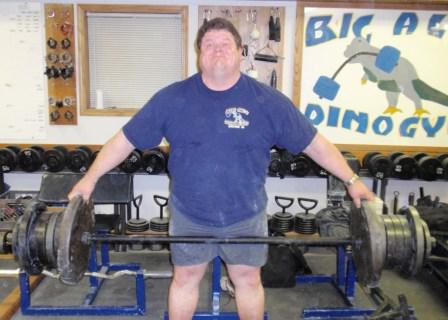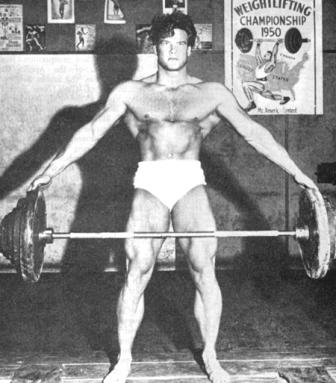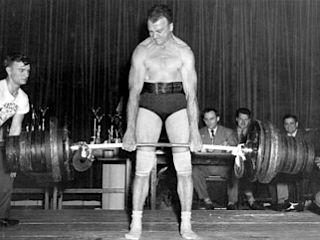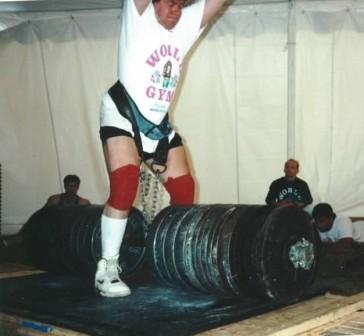by Al Myers
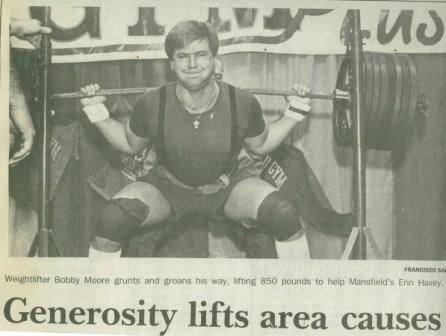
Bob Moore squatting at a fundraiser for a young girl with cancer. His efforts raised over $4000.
Al: I know you were involved in several big meet promotions. Could you tell me a little about the meets that you directed.
Bob: I had the opportunity to direct several large, successful USAWA and powerlifting meets, one being the 1992 USAWA National Championships. If I recall correctly, it was one of the first USAWA meets to secure major sponsors (Budweiser, PepsiCo, etc). The site for the meet was a great location, and the local hotel we worked with had a great nightclub for everyone’s enjoyment. Town officials even got involved and handed out the trophies during the awards ceremony. Other meets I directed involved a bench press meet at a nightclub; we had a huge turnout and a lively environment. I also co-promoted several meets with a close friend, Howie Waldron. Knowing that a strong support staff can make or break a meet, we worked with the Warrior Weightlifting Team, which consisted mainly of Coyle Cassidy High School powerlifters. One particular meet was held in a huge grand ballroom – with state of the art equipment, food and drink for the lifters, and huge trophies for the winners. The meet netted thousands of dollars, which in turn was donated to the Warrior team, which enabled them to take the trip to the Teenage National Championships.
Al: I am glad to hear that you will be making a “comeback” into All-Round Weightlifting. The USAWA needs individuals like you involved in our sport. Do you have any views on the future of the USAWA?
Bob: I believe there is tremendous growth potential, maybe more than any other sport, for the USAWA. However, the USAWA and IAWA need to make a concerted effort in bringing the sport to the public. Efforts should be made to recruit more lifters, and to make it more of a mainstream sport. Powerlifting and Olympic lifting are known by just about everyone who sets foot in a gym. When I was training for USAWA events, my training would naturally draw questions and interest from other gym members. When it came to presenting to Corporate Sponsors, I found they loved the idea and eagerly wanted to get involved. How many other sports can you find a 13 year old and an 80 year old competing side by side? A few suggestions would be to have trained persons work in a public relations role to make the equipment, lifts, etc, more widely know by a bigger audience than currently exists. There should be a “core” set of lifts that are familiar to the public; lesser known lifts can be introduced at a later time. Demonstrations prior to powerlifting meets would be both informative and entertaining. More head to head competition would also give the sport a needed boost, whether done by weight class or age. With a great set of records in the books, the USAWA and IAWA need to make sure these records, as well as new ones are challenged in dynamic and creative ways.
Strength sports in general have always been divided by drugs, big egos, and equipment. The future of all strength sports is dependent on the credibility of their respective organizations. The USAWA has major advantages over other strength sports; it does not have any splinter organizations, we have one set of record books, strict drug testing rules are in place and there is no equipment that affects lifts. It is my hope that the USAWA can take advantage of the huge opportunities that lie ahead of the organization.
Al: Bob, thank you very much for doing this interview. As a final question – What advice would you have for a new weightlifter that is interested in All-Round Weightlifting?
Bob: Don’t be afraid to ask questions! Weightlifters love to talk! They would love a new set of ears to talk to, don’t be afraid to talk to them. The key to success in any area of your life is knowledge. When I needed help with my back lift I called the king of all back lifters, Paul Anderson. Who better to ask? He turned out to be a wonderful source of information, as well as a nice, kind individual. He also became my role model later in my lifting career, and life. To this day I still donate to the Paul Anderson Youth Home (www.payh.org).
Young lifters should surround themselves with successful, dedicated, positive, knowledgeable lifters; there is no room for doubt or negativity when you are training. Failure is not an option. As weightlifting is an art form, young lifters also need to study the mechanics of the lifts they are going to be performing. Just because someone can lift a lot of weight does not mean they are doing lifts in the most effective way. Minor changes in hand, foot, knee or shoulder position can lead to major gains. There is no “one size fits all” when it comes to the All-Rounds or strength sports as everyone has different proportions, strengths and weaknesses. My 17 year old brother, Ryan, has broken several long standing teen and high school powerlifting records with techniques that are slightly different than my own. His squat and deadlifts are both well over 600, and his bench is going over 400 now at a bodyweight of 242. His body is different than mine so we made the proper adjustments in his training.
If I may say one more thing before this interview ends, all the talent in the world is of little to no value if you do not use it to help others. Use your God given talents to help others! Go out and make a difference in the world!
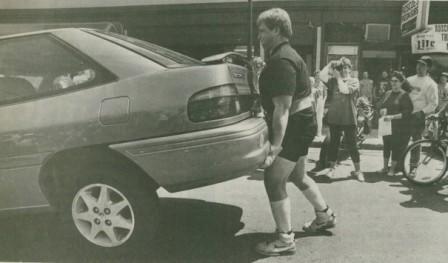
Bob Moore lifting a car at a fundraiser sponsored by Venture Sports on Founder's Day in Mansfield, MA. The weight of the car was 3430 pounds!
